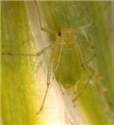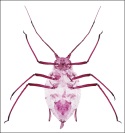Classification
Aphidinae: Macrosiphini
Common name(s)
Asian sowthistle aphid
Diagnosis
Medium sized (2-2.15 mm) aphid, spindle-shaped. Pale greenish or almost white, dusted lightly with white waxy powder. Legs, siphunculi, and cauda pale, apices of antennae dark. Antennae as long as body. Siphunculi 1.57x as long as cauda. The aphid is found on the undersurface of leaves and flower stalks of the host plants. Not attended by ants, honeydew excretion also very low. Infested plants exhibit no visible damage.
The aphid is found on host plants growing in shady areas or near water source.
Distribution
Africa, Australia, New Zealand, Fiji, Japan, Java, Taiwan, India (Karnataka, Nagaland, Sikkim, Tamil Nadu, Uttar Pradesh, West Bengal).
Host plant(s)
Asteraceae: Sonchus arvensis Linn.
Measurements
Aptera: Length of body 2.36, width 1.14; antennae 2.33, segments III: IV: V: VI 0.56: 0.32: 0.33: (0.13+0.59); u.r.s. 0.11; h.t.2 0.11; siphunculus 0.44; cauda 0.28.
Alata: Length of body 2.45, width 0.92; antennae 2.44, segments III: IV: V: VI 0.62: 0.32: 0.30: (0.12+0.60); u.r.s. 0.12; h.t.2 0.12; siphunculus 0.39; cauda 0.25.
Seasonal occurrence
January-February, June-July and September-October in and around Bangalore; more or less prevalent throughout the year.
Natural enemies
Coleoptera: Coccinellidae: Hippodamia variegata (Goeze).
Hymenoptera: Braconidae: Aphidiinae: Aphidius sonchi Marshall, Ephedrus lacertosus (Haliday), E. plagiator (Nees).
_sml.jpg)
_sml.jpg)

_sml.jpg)
_sml.jpg)
_sml.jpg)
_sml.jpg)
_sml.jpg)
_sml.jpg)
_sml.jpg)
_sml.jpg)
_sml.jpg)
_sml.jpg)
_sml.jpg)

